|
T of C
Home |
My Work |
Hand- books |
Qin as Object |
Qin in Art |
Poetry / Song |
Hear, Watch |
Play Qin |
Analysis | History |
Ideo- logy |
Miscel- lanea |
More Info |
Personal | email me search me |
| Confucian Theme Yi Jing (I Ching) | 首頁 |
| Confucius Reads the Yi Jing1/Leather Bindings2 | 孔子讀易、韋編 |
| - standard tuning: 5 6 1 2 3 5 6 (later 1 2 4 5 6 1 2?)3 | Wei Bian/Kongzi Du Yi |
| "Leather Bindings Thrice Worn Out" (bindings?4) |
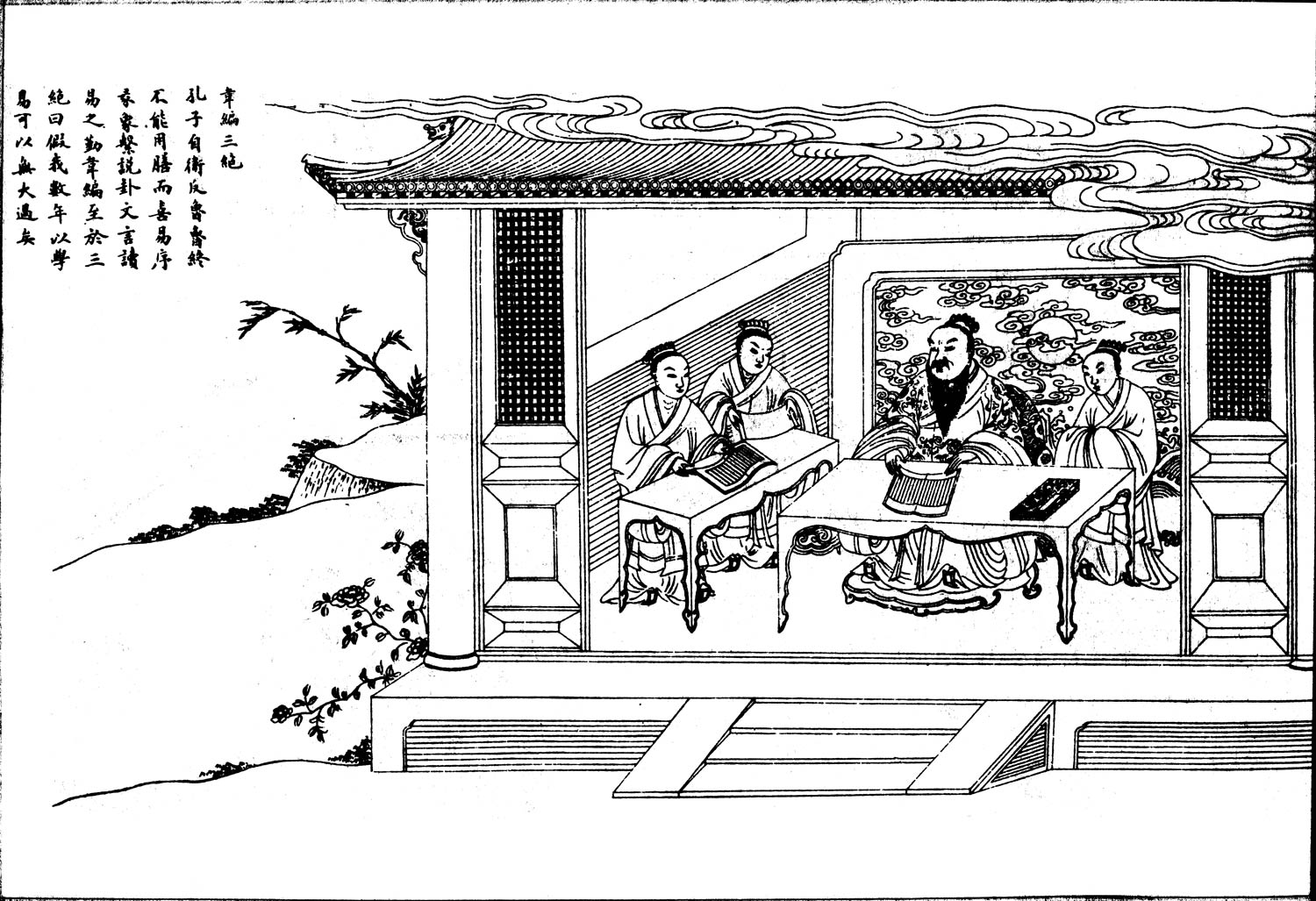 This is an examination of the sources for the melodies played today generally under the title Kongzi Du Yi (Confucius Reads the Yi Jing). My own long-time focus has been reconstructing and playing melodies as published during the Ming dynasty, and within this my custom has always been to try to reconstruct the earliest known version of any melody.5 So, because the earliest surviving known version of melodies connected to this title is the one published in 1738 under the title
Wei Bian (Leather Bindings), one of my aims here is to pursue the claim made by Zha Fuxi in his Guide that Wei Bian "came from the people of the Ming dynasty."6 As for the music itself, although it is easy to find related recordings, especially under the title Kongzi Du Yi, they almost always use nylon metal strings. And so, because this website focuses on the traditional
silk strings, the first references here are to four historical silk string recordings linked here from the 30-CD collection called Sitong Shenpin:
This is an examination of the sources for the melodies played today generally under the title Kongzi Du Yi (Confucius Reads the Yi Jing). My own long-time focus has been reconstructing and playing melodies as published during the Ming dynasty, and within this my custom has always been to try to reconstruct the earliest known version of any melody.5 So, because the earliest surviving known version of melodies connected to this title is the one published in 1738 under the title
Wei Bian (Leather Bindings), one of my aims here is to pursue the claim made by Zha Fuxi in his Guide that Wei Bian "came from the people of the Ming dynasty."6 As for the music itself, although it is easy to find related recordings, especially under the title Kongzi Du Yi, they almost always use nylon metal strings. And so, because this website focuses on the traditional
silk strings, the first references here are to four historical silk string recordings linked here from the 30-CD collection called Sitong Shenpin:
- Kongzi Du Yi played by Gu Meigeng "from Baipingzhai Qinpu" (originally Wei Bian but see 1876; listen)
- Kongzi Du Yi played by Liu Zhaoxin (source not mentioned: Baipingzhai/1876? listen)
- Kongzi Du Yi played by Yue Ying "from a hand-copy" (melodically very different; originally Weibian Sanjue; pdf; listen)
- Kongzi Du Yi played by Xu Tonghua "from a hand copy" (Guangling? Related to Yue Ying's, but see details; listen)
Although these four recordings are all called "Kongzi Du Yi", they seem to comprise variations of two different melodies, as indicated. Although the two have similarities, their basic difference is that the first two (like all the other early versions) treat the first string as do, while the latter two treat the third string as do (comment).
Discussing the variations in further detail requires comparing not just these four but also other tablatures. Such versions can be found with at least five titles:
- Confucius Reads the Yi Jing (孔子讀易 Kongzi Du Yi)
- Reading the Yi Jing (讀易 Du Yi)
- On Autumn Evenings Reciting the Yi Jing (秋夜讀易 Qiu Ye Du Yi)
- Leather Bindings (韋編 Wei Bian)
- Leather Bindings Thrice Worn Out (韋編三絕 Weibian San Jue)
In sum, the various melody titles that must be discussed here can cause quite a bit of confusion, but they are all connected through the story, related below, that in his old age Confucius so loved to study the Yi Jing (Book of Changes) that he wore out the leather strips binding the book's wooden blocks three times but still did not feel proficient.
The earliest surviving tablature for these melodies seems, as mentioned, to be the one called "Leather Bindings" (韋編 Wei Bian), in the handbook "Qin Book of 1000 Antiquities" (琴書千古 Qinshu Qiangu, 1738). This collection of handwritten tablature was apparently compiled in Henan province, with the music said to be reflective of the 中州派 Zhongzhou School. The compiler of that handbook is not known, so there is apparently no information as to when the melodies were actually collected. And although the versions of the common one played today can usually trace their origins to the 1738 Wei Bian, now they are (like the one above by Gu Meigeng) usually based more directly on ones in newer handbooks such as Baiping Zhai Qinpu (1850s? See 1876.)
The second surviving tablature, called "Reciting the Yi Jing (讀易 Du Yi), is in a handbook called 琴學練要 Qinxue Lianyao, published just one year later in Chang'an (modern Xi'an), 1739. This melody has only four sections compared to seven in 1738, but its sections are longer, so the actual melodies seem to be of similar length. Modally, however, they seem rather different (on this see comments below on section-ending notes).
A preliminary examination suggests that the Kongzi Du Yi recorded by Gu Meigeng and Liu Zhaoxin may be related to both the 1738 Wei Bian and the 1739 Du Yi, but both are melodically and modally closer to 1738. As for the source of these earlier two, without evidence showing that one developed out of the other one might assume they both came from an earlier source, now lost. However, a source as early as the Ming dynasty may be difficult to prove.
All known early versions of melodies connected to these titles
Zha Fuxi's Guide traces these through three relevant entries:
However, the above list of titles is incomplete as well as perhaps misleading in its grouping of the melodies. For example, the
melody played by Yue Ying elsewhere under the title 韋編三絕 Weibian Sanjue is linked above with the title Kongzi Du Yi, and
Zha's Guide has Kongzi Du Yi as an alternate title for Du Yi, but it actually seems more closely related to Wei Bian.
The following now arranges all the known examples of these titles into four melodically related groups.
Grouping the pieces by melodic relation
Regarding these four groups, here it will be seen that Group 3 seems to have developed from Group 1 and maybe 2, while their connection with Group 4 has not yet properly been examined.
There is no commentary with this handbook. The handbook itself was apparently copied out somewhere in Henan, and so its music is said to be in 中州派
Zhongzhou Style.
The melody is clearly connected to some of the melodies now called Du Yi, or Kongzi Du Yi, but the attempts made here to point this out are rather preliminary.
Musically this piece begins (see the original tablature at right) 10-67↓↑-20-77-30-76.2-40-76.2↑.... With 5 6 1 2 3 5 6 being the relative tuning, the beginning note sequence is 5-535-6-6-1-1-2-12....
There do not seem to be any available recordings based specifically on this handbook, but based on the tablature itself it does seem that in spite of the modal differences it does have motifs in common with the Kongzi Du Yi played by Gu Meigeng in this recording said to be from
Baiping Zhai Qinpu
(same for Liu Zhaoxin).
The four sections of Du Yi (next) are each generally longer than the seven sections here. This may make the overall length of the two vesions similar, but I have not yet been able to align them.
There are further comments in Footnote 2.
The tablature begins with a harmonic passage
27-77-49-77。57-47-39-47-57-47-65 。....It then ends on 7727. It does not seem to share as many motifs with 1876 as 1738 does. The afterword here says,
This also seems to be the only version with section titles, as follows:
Though dated one year later than Qinshu Qiangu, the mere fact that Qinxue Lianyao was printed suggests that its content could well be older.
The recording by Gu Meigeng, very similar to this, credits
"Baiping Zhai Qinpu". For much of the melody the two tablatures are identical, but it looks as though Baiping Zhai made some corrections (see in particular the ending, just before the harmonic coda), which may suggest that the current edition of Baiping Zhai was actually written down later. Commentary in 1876 says "閩派 Min pai" (Fujian school) but "from 孔山 Kongshan", a Sichuan master originally from Zhejiang. Does this suggest it was a melody that Zhang brought with him to Chengdu when he moved there? Baipingzhai has an afterword but it does not mention any of this. Recordings of this piece by 曾成偉 Zeng Chengwei (metal string) are also very similar to this tablature but are said to be 蜀派 Sichuan school.
A comment at the front of the tablature/transcription in Guqin Quji (p. 265) says its source is 賈闊峰傳譜 tablature transmitted by Yue Ying's teacher 賈闊峯 Jia Kuofeng. Jia himself was a student of 黃勉之 Huang Mianzhi (zh.wiki; 1853—1919). Huang is said to have been representative of the 九嶷
Jiu Yi School, but he was also associated with Kuangling players. It is not clear whether Huang himself also played this melody. The fact that a melody like this does not appear in any of the old handbooks suggests perhaps Huang created something like this for his own students: inspired one of the other melodies here?.
The brief commentary on p. 10 of Guqin Quji adds that the melody survived only through that hand-copy, no printed scores. It then suggests that this modern melody is related to that of the Wei Bian in the 1738 handbook and points to the story shared with Kongzi Du Yi, as mentioned above. However, my own tentative examination comparing the two Wei Bian tablatures did not reveal much musical relationship between them, nor between either of them and any of the Du Yi melodies mentioned next. Thus the actual source of this melody is unclear.
No tablature; recording by Xu Tonghua
Comparing Xu Tonghua's performance with the transcription of Yue Ying's, after adding the gunfu, Xu plays what in Sections 1 and 2 seems like an elaborated version of Yue Ying Sections 1 and 2. As for Section 3, the first line of the transcription shows it to be identical to the first line of Section 2 and here Xu Tonghua, either by mistake or deliberately, continues by repeating Section 2. Then, instead of going on to Section 3, she simply repeats the gunfu from the beginning and ends by playing the octaves on re do re that are at the beginning of Yue Ying's performance.
Other recordings of this version seem mostly to follow Yue Ying, but I have not done a study of this.
1.
Confucius Reads the Yi Jing (孔子讀易 Kongzi Du Yi)
Zha Fuxi's Guide does not give a reference to Kongzi Du Yi as a title until
1876 (though see also
Baipingzhai Qinpu). Interestingly, the earliest reference to "Du Yi" as a melody title seems to come not from the 1738 melody Wei Bian, to which the 1876 melody is melodically similar, but to the 1739 Du Yi, which mentions "on autumn evenings reciting the Yi Jing" (秋夜讀易 qiu ye du yi) in its afterword but seems to be quite a different melody.
Correspondingly, it remains unclear how the melodies played by Yue Ying and Xu Tonghua, linked above, came to be called Kongzi Du Yi.
This story is also recounted in Book 10 of
Shuo Yuan.
2.
Leather Bindings (韋編 Wei Bian)
The original title of this melody is clearly connected with the ones called Leather Bindings Thrice Worn Out (韋編三絕 Wei Bian San Jue/Weibian Sanjue, but their musical relationship is unclear (see below). Both of these Wei Bian melodies tell the same story. Literary references include:
Confucius is also quoted as having said that "if he had fifty years to spare, he would devote them to the Yi Jing." And it is often said that Confucius wrote the commentaries on the Yi Jing called the "Ten Wings". However, modern scholars say he didn't actually write anything: he taught and spoke to his students and they wrote this down, as did their successors. So although the story that "Confucius Read the Yi Jing" was probably not written down until many years later, it is thought to be a true story and is then of course a natural title for a qin melody.
The introductions to Du Yi do not actually mention Confucius except where his name appears in the title (i.e., the Kongzi Du Yi from 1876). Nevertheless, from the titles it would seem that the theme of the Du Yi melodies might be similar to that of the Wei Bian melodies.
Again, although further study might show in more detail the musical relationships between the Wei Bian melodies or between them and the Du Yi melodies, until that time one should be skeptical of any claims one can read that 韋編三絕初見於《琴書千古》(1738,抄本)Yue Ying's version of Wei Bian San Jue can be traced back to 1738. In fact it has not even been traced back prior to Yue Ying and/or her teacher. It should be needless to add that, though this is criticism of the commentary, it is also in fact praise for the performer.
3.
Standard Tuning: first or third string as do
Here all the early versions seem to treat the tuning as 5 6 1 2 3 5 6, while the later versions, perhaps beginning with the one by Yue Ying, treat the tuning as 1 2 4 5 6 1 2. However, I have not yet carefully analyzed the precise modal characteristics.
string#position#-, with ↑ and ↓ indicating slides, and - marking off separates notes.
Thus "7020-" is open 7th and 2nd strings played in unison.
The information here about the melodies must be considered particularly tentative as I have not myself played through them.
1738 tablature
(pdf)
7
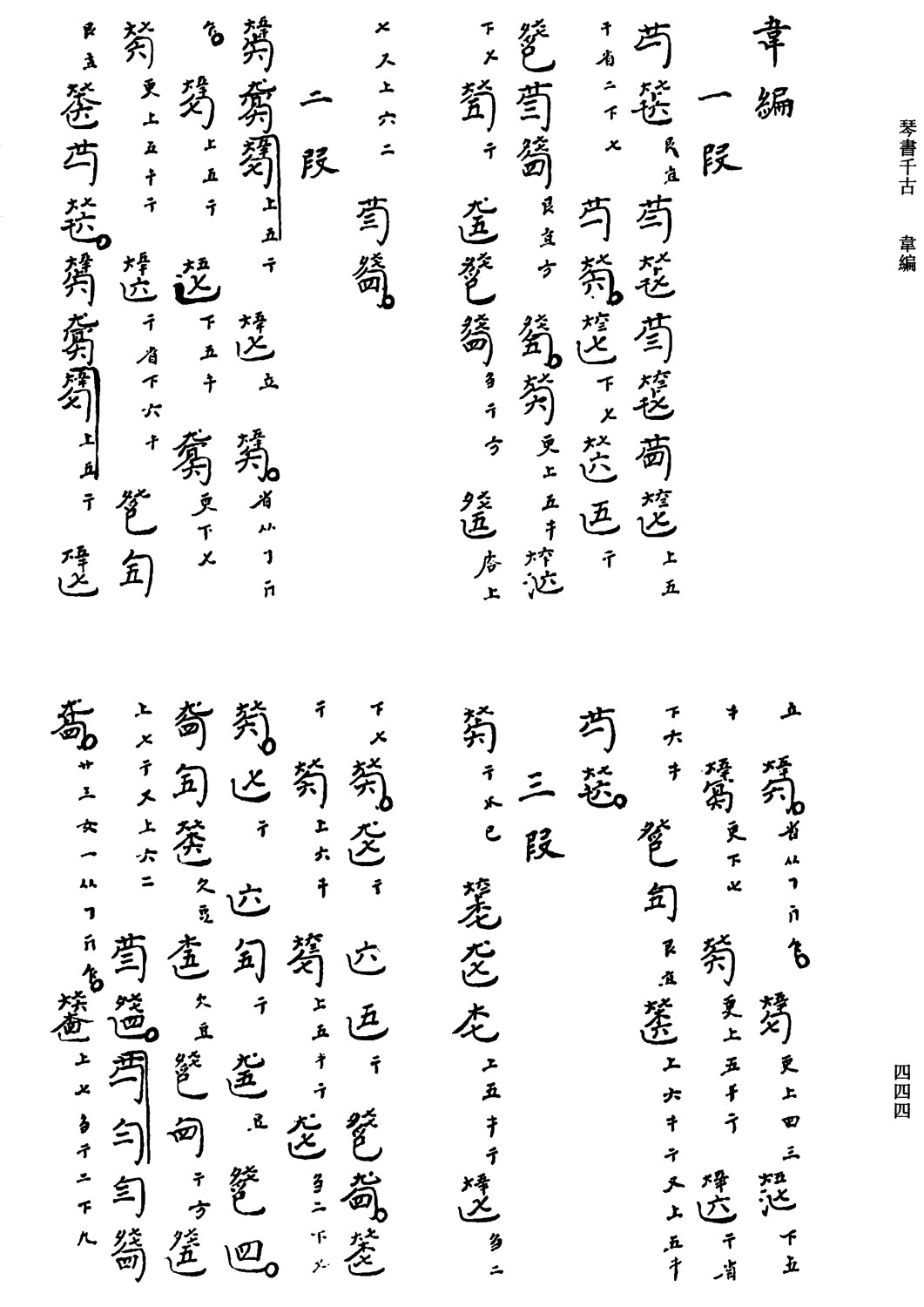 This is the only melody that Zha (39/--/--) lists with this title; 7 sections. The mode is not indicated. With relative tuning 5612356 the six sections and coda end on the relative pitches 1, 5, 1, 1, 5, 5 and 1 over 5 respectively. This would normally make it a do-sol mode such as gong mode or, maybe better,
zhi mode (compare 1739, next, and 1876 below).
This is the only melody that Zha (39/--/--) lists with this title; 7 sections. The mode is not indicated. With relative tuning 5612356 the six sections and coda end on the relative pitches 1, 5, 1, 1, 5, 5 and 1 over 5 respectively. This would normally make it a do-sol mode such as gong mode or, maybe better,
zhi mode (compare 1739, next, and 1876 below).
1739 tablature
(pdf)
8
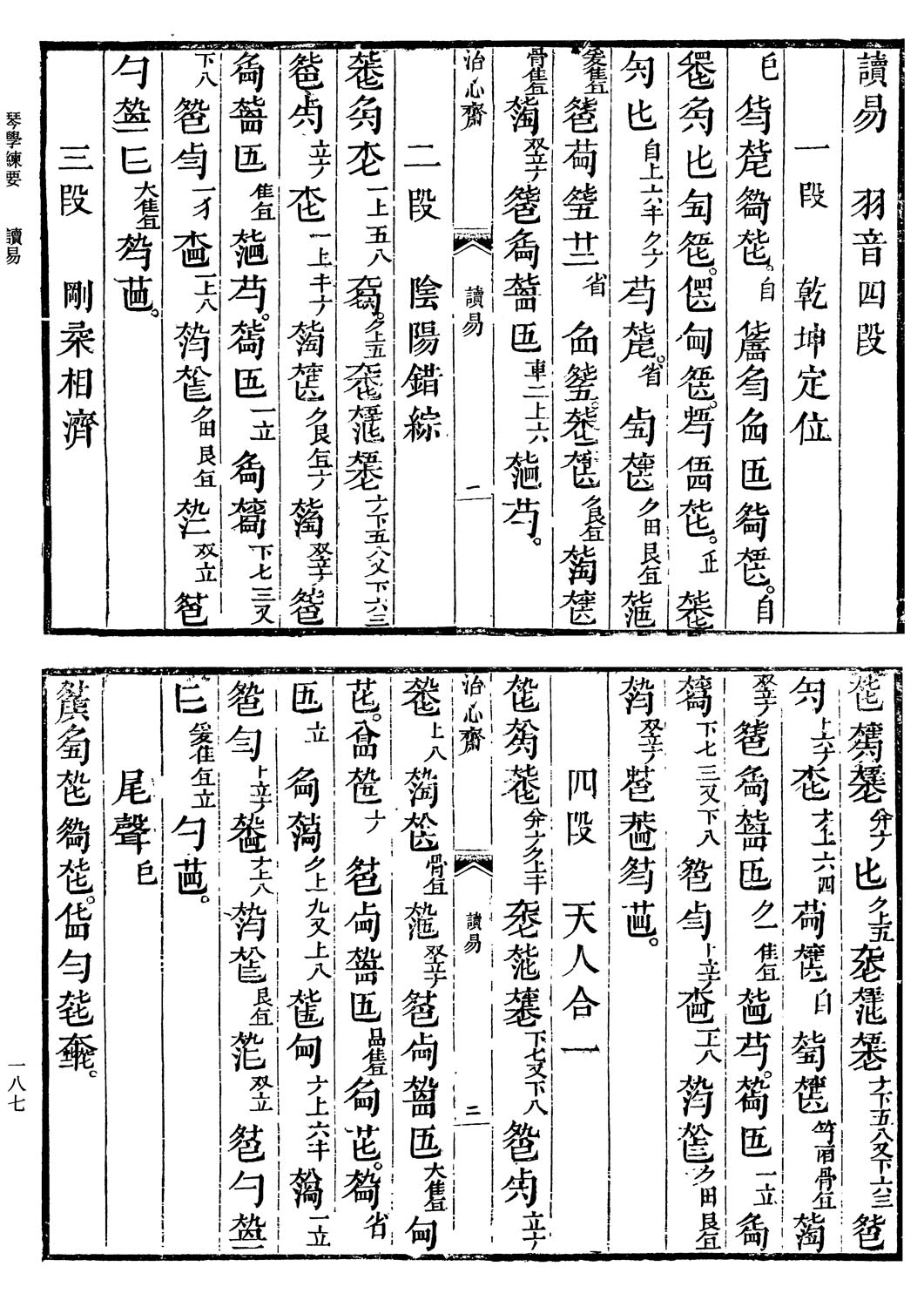 Zha's Guide lists
Du Yi
(39/267/--) in five handbooks from 1739 to 1876, with
Confucius Reading the Yi Jing (孔子讀易 Kongzi Du Yi) included only as an alternate title for Du Yi. It also includes as an alternative title On Autumn Evenings Reciting the Yi Jing (秋夜讀易 Qiu Ye Du Yi). Of these five, however, the one from 1876 is quite different, so only four of the five handbooks are considered here actually to have related melodies, as follows:
Zha's Guide lists
Du Yi
(39/267/--) in five handbooks from 1739 to 1876, with
Confucius Reading the Yi Jing (孔子讀易 Kongzi Du Yi) included only as an alternate title for Du Yi. It also includes as an alternative title On Autumn Evenings Reciting the Yi Jing (秋夜讀易 Qiu Ye Du Yi). Of these five, however, the one from 1876 is quite different, so only four of the five handbooks are considered here actually to have related melodies, as follows:
Du Yi; 4+1 sections, titled; yu yin (yu mode). In this mode the relative tuning is usually 5612356 with the tonal center the note yu [la], secondarily jue [mi]). Here, however, the tonality seems more complex, beginning and ending with the tonal center on la but in between having tonal centers on re (2) or sol (5).
(Paraphrase:) Friends on autumn evenings liked to read the Yi Jing aloud, and the sound inspired the writer to create this melody (see also du shu sheng).
Qiu Ye Du Yi (On Autumn Evenings Reciting the Yi Jing Aloud); yu yin; 3+1 sections; no commentary; begins almost as 1739 (harmonic passage 77-27-49-77。57-47-39-47-57-47-...., ends on la with intermediate sections ending on re), but there are many differences (e.g., it combines 1739 sections 1&2).
Qiu Ye Du Yi; 4+1 sections; huangjun jun, shang yin; almost same as 1739 but also begins harmonic passage 77-27.... Has afterword that says:
Not yet translated.
Du Yi; 3 sections; I have not yet seen the tablature.
This music by Li Xiangshi, should be played in the style of the Sichuan school, and especially at the beginning is quite pleasurable. (Comment by)
Ye Shimeng.
1850s tablature?
(pdf)
9
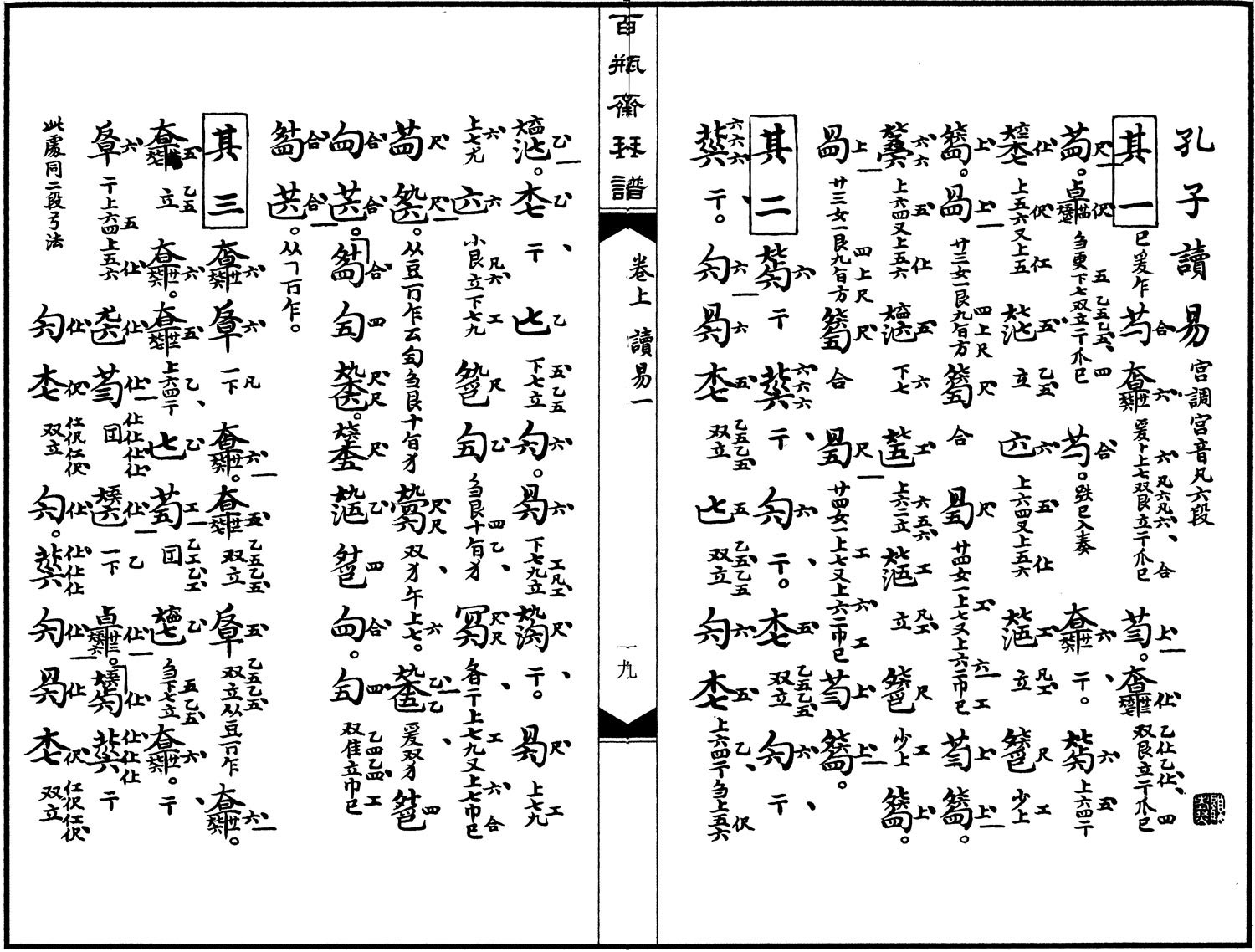 Zha's Guide has this only as an alternate title for 1738); three closely related examples are included in this group.
Zha's Guide has this only as an alternate title for 1738); three closely related examples are included in this group.
Kongzi Du Yi; 6 sections; gong yin; zhi diao; begins 10-106↑7↓↓↑↓67-30-3076.2.... By my analysis, with relative tuning considered as 5612356 the six sections and coda end on 1, 5, 1, 1, 5, 5 and 5 (5 is zhi, hence "zhi diao": zhi mode).
Kongzi Du Yi; this modern facsimile edition allows this handbook also to be added to this list. As just mentioned, based on my examination its tablature for Kongzi Du Yi is virtually identical to that of Tianwen'ge Qinpu (1876), but with some corrections. A comment with the 1876 tablature says it came from Zhang Kongshan. If this means that the Baipinzhai version was also that of Zhang Kongshan it is somewhat strange that this wasn't mentioned somewhere else.
Kongzi Du Yi; source not identified there, but music again seems to come from Baipingzhai/Tianwen'ge.
Yue Ying's version (pdf)
10
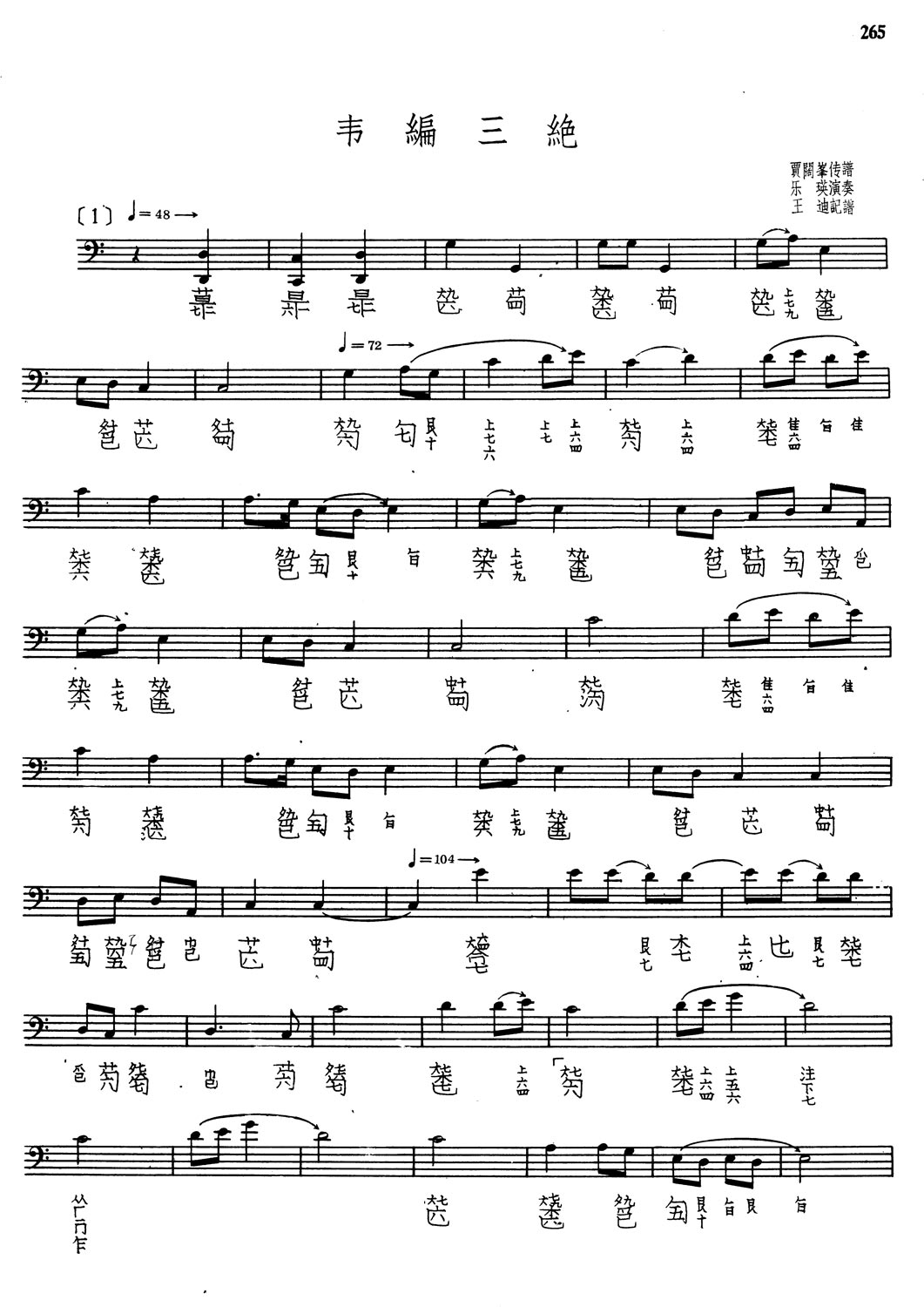 Two identical recordings from the 1950s by Yue Ying, on:
Two identical recordings from the 1950s by Yue Ying, on:
- CD #6 of the China Records 8-CD set; transcribed in Guqin Quji, Vol. 1, pp. 265-7; called Weibian Sanjue.
- CD8-C of the
30-CD CNAA set, called Kongzi Du Yi, with Weibian Sanjue given as an alternate title.
Online I have heard versions like this that are also called 秋夜讀易 Qiu Ye Du Yi.
As with Yue Ying (see transcription at right) the tuning is 1245612 and it also has three sections.
However, here the melody begins with a
gunfu on open strings 654321123456 before continuing with 7020-6010-7020-. 69-40-69-. 69-69-40-69↑-.59-69-59↑↓-510-60-410....
Footnotes (Shorthand references are explained on a
separate page)
孔子讀易 Kongzi Du Yi 7077.xxxx; 讀易 Du Yi 36928.xxx.
Perhaps "Confucius Recites the Yi Jing" would be a better translation of the title, as "讀 du" suggests reading aloud.
(Return)
The available existing tablature for the only melody called Wei Bian坐對韋編燈動壁,高歌夜半雪壓廬。
Not yet translated.
無大過矣
孔子晚而喜易,序、彖、繋、象、說卦、文言,讀易韋編三絕。「假我數年,若是,我於易則彬彬矣。」
"In his old age Confucius loved to study the Book of Changes, the order of the hexagrams, definitions, appendices, interpretations, explanations and commentaries. He studied this book so much that the leather binding the bamboo or wooden strips wore out three times. "Give me a few years more," he said, "and I shall become quite proficient!"
(Return to top or footnote 2)
Standard tuning can be treated as 5 6 1 2 3 5 6, i.e., with the open third string as having the relative pitch do (1; gong), but it can also treated as 1 2 4 5 6 1 2, with the open first string having the relative pitch do. Tuning is separate from mode, which is determined by which pitches are emphasized. For more on this see
Modality in Early Ming Tablature.
(Return)
| 4. Image: Leather Bindings Thrice Worn Out | A bamboo/wooden slips museum |
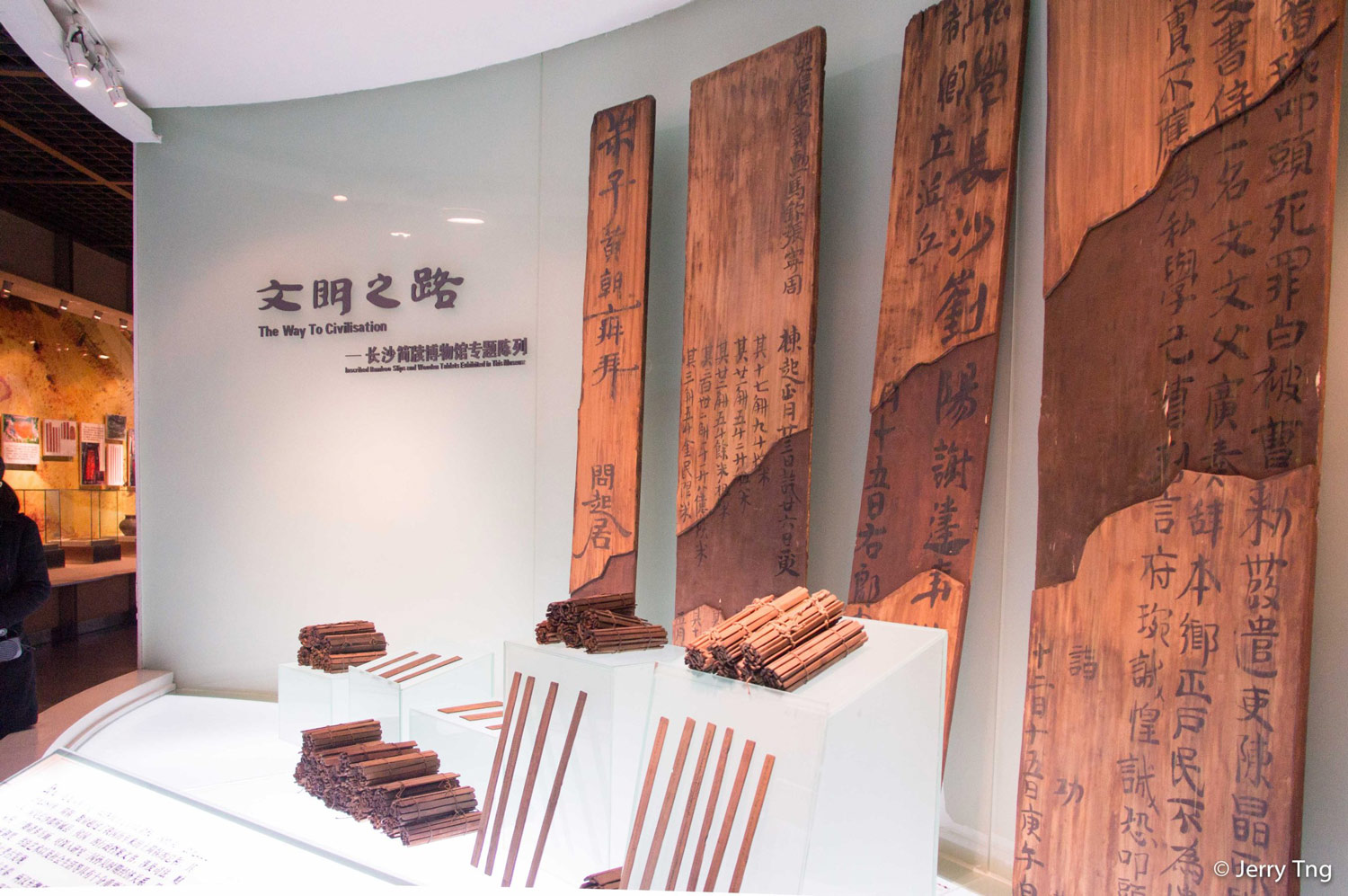 As described in Wikipedia these bindings could be made from silk or hemp as well as leather. As for the image at right, it was linked to a page on live2makan.com, which is about the Changsha Bamboo Slips Museum
(長沙簡牘博物館
[English;
首頁]);
another image from live2makan.com shows how they may have been bound.
As described in Wikipedia these bindings could be made from silk or hemp as well as leather. As for the image at right, it was linked to a page on live2makan.com, which is about the Changsha Bamboo Slips Museum
(長沙簡牘博物館
[English;
首頁]);
another image from live2makan.com shows how they may have been bound.
Getting back to the Yi Jing itself, the text accompanying the image above, after the title, says,
It begins by saying that after returning home from the Wei kingdom to Lu, Confucius was no longer employed. It then continues largely according to the text in Annals of the Grand Historian, as translated here.
The image, showing Confucius reading the Yi Jing, was copied from p.20 of a book called 孔子聖蹟圖 Traces of the Sage Confucius, p.20. Usually such images show his book to be in the traditional woodblock print on paper format (which perhaps began around the end of the Han dynasty), not the earlier system of writing on bamboo slips tied together with leather bindings (簡牘 Wiki), as in this footnote.
(Return)
5.
Reconstructing
Because I do the earliest version of any particular melody, generally speaking I mainly look at later versions to help me understand the earliest one. This requires much less analysis that what is going on here, where I am (least until such a time as I select one for reconstruction) treating the different versions more equally.
To put this another way, I always hope the beauty of the early melodies will inspire someone to take the time to trace their passage over time - somewhat as is done here - while I just go on to my next reconstruction.
(Return)
6.
Image: the earliest tablature (1738)
Copied from QQJC XV/444.
(Return)
7.
Image: the second surviving tablature (1739)
Copied from QQJC XVIII/187-8.
(Return)
8.
Originate in the Ming dynasty?
Zha Fuxi's Guide, under
Wei Bian
(39/--/--), p.39, says it is "明代民間 from the people of the Ming dynasty" whereas under Du Yi
(39/267/--), p.39, it says Du Yi is from "清王元伯 Wang Yuanbo of the Qing dynasty" (reference is to 治心齋琴學練要 1739). The referenced Wei Bian melody (published 1738) seems at first glance to be more connected to the modern versions of Kongzi Du Yi than does the tablature for the 1739 Du Yi melody, but those two are close enough that one can guess that they might both have come from an earlier original. Whether or not this can take the melody back to the Ming dynasty, the part of Zha's origin claim that the melody came from "among the people" should in any case probably be seen more as a political statement of the time rather than as an historical one. The actual age and source of these melodies seems still uncertain.
(Return)
9.
Kongzi Du Yi in Baiping Zhai Qinpu (1850s?)
Copied from a facsimile edition of what is said to be a handbook compiled in the 1850s, but it was quite likely re-done for modern publication.
(Return)
10.
Staff notation of Yue Ying performance
This is 1950s staff notation from
Guqin Quji
(Return)
Return to the annotated handbook list or to the Guqin ToC.